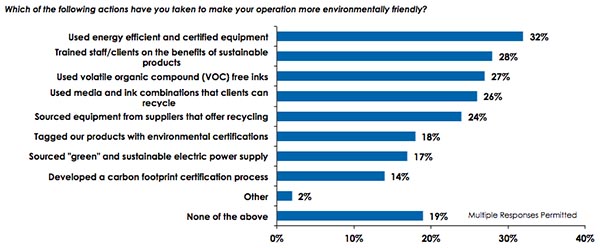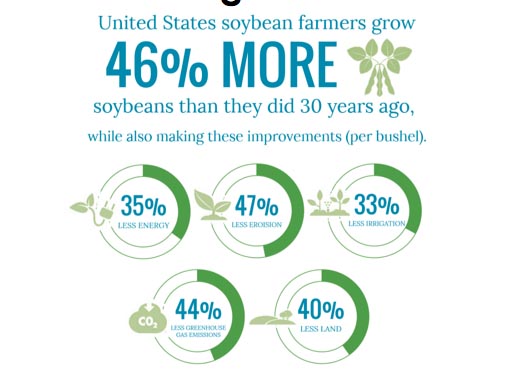- The printing market has faced an uphill battle in creating an eco-friendly image as many people still associate it with deforestation and pollution.
- By embracing wind and solar power, printing businesses can position themselves as cleaner companies that are reducing the power of COVID-19 and other respiratory illnesses.
- To achieve a pure image of eco-friendliness, print service providers must be prepared to do their due diligence and only buy from suppliers that share their commitment to sustainable business practices.
By Colin McMahon
Introduction
Sustainability and the promotion of eco-friendly practices have been a priority within the printing industry for years. If the available data is any indication, the focus on the environment is stronger than ever. According to the Printing United Alliance, the recycling rate has doubled in the past 25 years. Furthermore, paper and pulp mills in the US now report generating roughly 66% of their own energy using renewable fuel such as biomass. These findings are encouraging—the printing market has faced an uphill battle in creating an eco-friendly image as many people still associate it with deforestation and pollution.
The COVID-19 pandemic has temporarily pushed the topic of climate change out of most headlines, but this will not remain the case forever. In addition, some research has already been published—and more will likely emerge—linking climate change to COVID-19. Although no one is saying that climate change directly caused the pandemic, some have suggested that certain practices likely increased the severity of the virus. Should these claims prove accurate, it will be more important than ever for the printing industry to present an eco-friendly face to clients and consumers. According to the FESPA Print Census, most businesses are taking actions to make their operations more environmentally friendly. The most common practices include using energy-efficient/certified equipment and providing training on the benefits of sustainable products.
FESPA Data on Sustainability Priorities

Source: 2018 FESPA Print Census
The Link between COVID-19 Severity and Air Quality
Air pollution is dangerous on its own, contributing to an estimated 7 million deaths on a global basis each year. This is particularly the case in cities with high levels of pollution and smog output. As if this was not enough, a recent study has shown a link between air pollution levels and the severity of COVID-19 cases. PM2.5 is a fine particulate matter pollutant that is typically generated from cars, power plants, fires, and dust storms. The presence of PM2.5 can damage lung tissue on its own, but a small increase in the amount of this substance noticeably increased the severity of coronavirus symptoms. For example, this study suggests that the widespread outbreak of COVID-19 in New York City is related to its high levels of PM2.5.
Printing firms that are hoping to reduce their contributions to PM2.5 levels can take a variety of measures. Although traditional power sources generate higher levels of PM2.5, solar and wind powers generate much less. The use of these new power solutions is increasing during COVID-19, and will likely play a greater role in energy production in the future. By embracing these technologies now, printing businesses can position themselves as cleaner companies that contribute less to the PM2.5 air problem, thereby reducing the power of COVID-19 and other respiratory illnesses.
Ink Diversity Means Less Toxic Waste
The printing industry can also reduce its carbon footprint with increased use of eco-friendly inks. Many older inks are petroleum-based and release dangerous compounds during the printing process. Additionally, these inks are tied to oil—a frequently damaging power supply that is notoriously harvested through practices like drilling and fracking. Newer ink technologies such as aqueous inks, soy-based inks, and vegetable-based inks do not produce these dangerous compounds. On top of that, these inks tend to be easier to clean and recycle after use. While it is true that not every printer on the market supports these new ink types, but most new machines do. Many of these eco-friendly inks are even cheaper to purchase than petroleum or oil-based inks, reducing operating costs after a compatible machine has been purchased.
Quick Facts about Soybean Production

Source: North Carolina Soybeans
The Power of Responsible Sourcing
Nature is a complex ecosystem, and the printing industry is as well. Everything is connected, so one aspect will always impact others. Printing companies might claim to be eco-friendly, but even the best reputation can be damaged if a firm does not adhere to responsible sourcing habits. Sourcing involves the supply chain, so the suppliers that printing companies buy from must be able to withstand scrutiny. Not all suppliers are equal when it comes to the environment. For instance, let’s imagine a company that uses all the eco-friendly inks in the world. This is a great start, but if that firm never buys from a supplier that uses recycled paper, how sustainable is it really?
It must also be remembered that recycled paper is just the tip of the eco-friendly iceberg. Suppliers often treat their materials with procedures like bleaching and coating. Although these practices can be done with sustainability in mind, they can also be performed irresponsibly. To achieve a pure image of eco-friendliness, print service providers must be prepared to do their due diligence and only buy from suppliers that share their commitment to sustainable business practices.
Another Advantage for Digital Printing
Although digital printing might still play a minority role in overall print production, its involvement is increasing—thanks in no small part to its ability to print more while producing less waste. Traditional production printing processes often generated quite a bit of unused materials. What’s more, mostly everything that was not sold by the retail partner ended up in landfills. Digital technology empowers printing on demand, eliminating warehouse waste and enabling customers to produce only what they need.
Because digital printing is designed to deal with shorter run lengths, it allows print companies to at least somewhat distance themselves from old supply chain constraints such as large-scale material orders. The new supply chain is shaping up to be smaller and more versatile, which hopefully translates to a positive environmental impact.
The Bottom Line
Climate change is an ongoing concern, and it’s not going to get better without real, sustained action. The COVID-19 pandemic has only served to show just how fragile the world and its societies can be in the face of a natural threat. The businesses that enjoy the most success during and after COVID-19 will likely be the ones that project themselves as environmentally responsible. More than ever, today’s consumers care about where their goods come from—and what they can do to become a sustainable part of the chain. With studies linking the severity of COVID-19 to pollution and likely more to come, savvy print businesses will focus their efforts on becoming as green as possible.
At the same time, however, these measures must go beyond the surface. Thanks to the Internet, people have the ability—and the time—to conduct research on the companies that they plan to buy from. As a result, investing in sustainable practices is not enough; print service providers must promote their efforts. It’s important to be transparent and demonstrate all efforts that have been made in the name of sustainability. For the printing industry, the future is green!
Colin McMahon is a Research Analyst at Keypoint Intelligence – InfoTrends. He primarily supports the Business Development Strategies and Customer Communications services. In this role, he creates and refines much of InfoTrends’ written content, including forecasts, industry analysis, and research/multi-client studies. He also assists with the editing and formatting processes for many types of deliverables.















Discussion
Only verified members can comment.